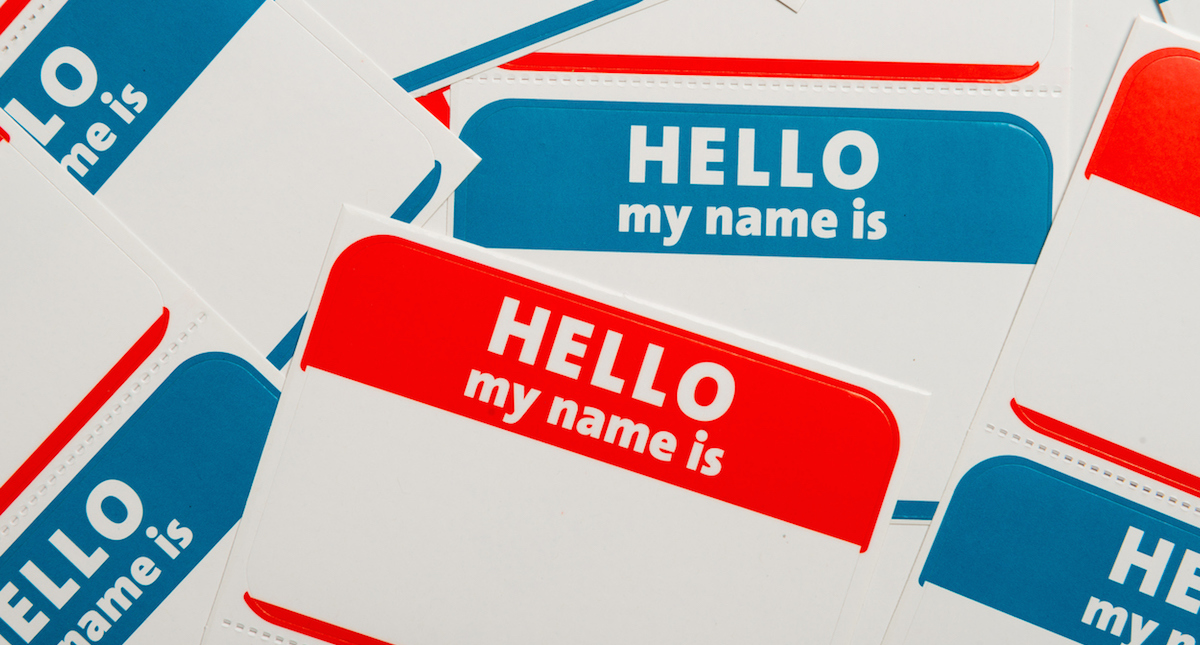Nir Eyal is an entrepreneur, educator, and author of the Wall Street Journal bestseller Hooked: How to Build Habit-Forming Products. A contributing writer to Forbes, TechCrunch, and Psychology Today, Nir explores in his writing the intersection of habits, technology and better business practices. He recently joined Alexandra Watkins, brand name expert and author of My Name Is Awesome for a conversation at the Nasdaq Entrepreneurial Center about the importance of choosing the right name for your business or product—and how so many people go wrong.
This conversation has been edited and condensed. To view the full conversation, click the video below.
Nir: Why are names so important?
Alexandra: Your name is your identity. It’s the first thing that people see when they come in contact with you, and it lasts forever. Your name’s going to be around longer than your most loyal employee, longer than your cell phone, your photocopier. Your name is probably the longest investment of something that you’ll own, so you want to make it good.
Nir: You’ve worked on some pretty prolific brand names. Can you tell us a little bit about your background and experience in the field?
Alexandra: I started out as an advertising copywriter. Every once in awhile I would get thrown a bone and get to name something, and I loved naming. I thought it was just something fun I did once in awhile—when I found out that naming actually was a profession, I thought, “Oh, I’m going to do that instead.”
I’ve been able to work on some really cool names and fun things: the ice cream store Smitten, which now has 10 locations, another frozen dessert company, Spoon Me Frozen Yogurt, the home robot Neato from Neato Robotics. They’ve been around 10 years and both founders just started new robotics companies, which I also named.
Nir: If I were starting a new company, maybe a line extension, a new brand, what do I need to think about when it comes to naming my product or service?
Alexandra: I created an acronym for this, SMILE, because a name should make you smile instead of scratch your head.
S: Suggestive.
A name should suggest something about your brand, a positive brand experience. Don’t make people guess.
M: Meaningful.
You want your name to be meaningful to your customers, not just to you or your engineers—we see that happen a lot in the Bay Area.
Trending: How to Transform Daily Habits into Life-Changing Rituals
I: Imagery.
People remember images and pictures in their head much more easily than they remember words or letters. [An image gives them something] to hook their brand onto.
L: Legs.
You can extend your brand through a theme. For instance, at Eat My Words, our blog is called The Kitchen Sink, and we have a package called The Whole Enchilada.
E: Emotional.
You have to make that emotional connection with people. It’s so important because people make purchasing decisions based on emotion.
Nir: That’s how to think of a great name. What about what not to do? What are some of the biggest mistakes that you see companies making?
Alexandra: There are a lot of mistakes. I’ll take you through SCRATCH really quick, [another acronym I created to highlight them].
S: Spelling challenge.
Ask Siri to find whatever your name is—if Siri doesn’t know what you’re talking about, I’d question the name. Or if it’s spelled in a weird way. You don’t want your name to frustrate people. You have to think of your name as a welcome mat. You don’t want it to be unapproachable where people are like, “What is that? How do I pronounce it?”
Nir: Do you think that companies like Google or Shyp succeed despite the name?
Alexandra: Yeah. [Shyp’s] office used to be around the corner from my office, and when I would walk around with people in the neighborhood, they’d say, “What is that? Shipe?” That’s an example of somebody getting a name because the domain name was available for $9.95 on GoDaddy.
C: Copycat.
After Twitter there was Yammer and Chatter. Don’t be a copycat, be original.
R: Restrictive.
You don’t want to outgrow your name. Look in the future and make sure that your name isn’t going to restrict you.
A: Annoying.
That’s where you spell your name backwards, like X-O-B-N-I—it’s inbox spelled backwards. Most people would not intuitively know that looking at it.
T: Tame.
You don’t want your name to just fade into the woodwork. You want it to stand out. There’s so many brands vying for people’s attention.
C: Curse of knowledge.
That’s where only insiders get it. Oftentimes it’s a foreign word or, back to the engineers, it’s meaningful to them, but not to your customers. Don’t give your name any disadvantages.
H: Hard-to-pronounce.
Back to the welcome mat, you want to be friendly and approachable.
I’d say all of those things are deal breakers.
Nir: Let’s go back to the [issue of] URLs.
Trending: 5 Reasons Life Gets Better After Your 40s
Alexandra: Domain names—let me just break some myths for you. If you can’t get an exact-match domain name, do not let that stop you from having a great name. You can add a modifier to it. For instance, up until very recently, if you went to Tesla.com, you would get a landing page that said, “This site is owned by Gandi Net.” Now, what would you do? Would you just give up? No, you’d just—
Nir: Google it.
Alexandra: Exactly. Then you’d see it, you’re there. Have you noticed what the domain name is? No. It’s Tesla Motors. Do you care? Are you not going to buy a Tesla because they don’t own Tesla.com?
Nir: Right. [Yet] you see people paying thousands of dollars for a special domain.
Alexandra : It’s heartbreaking—I heard of an author who recently paid thousands of dollars for a domain name that was the exact name of his book. If he had just added the word “book” it would have actually helped with his search engine optimization.
Nir: Because people aren’t typing in necessarily the URL. They’re being linked from somewhere, typically Google.
Alexandra: Just add a modifier—if it can help you—and a descriptive word that can help in the SEO. Do that, save some money.
Nir: What if we’re building a new product and we’re really just in the beginning days, how do we brainstorm?
Alexandra: Great question. Sitting in a room staring at a whiteboard is not where colorful ideas come from. In the old days that’s what we had to do, but now we have the internet. We have this instant brainstorming tool right in front of us. Go to Google Images or to a stock photo library and type in a concept word.
“A picture says a thousand words, and that’s way more efficient than sitting in a room with a bunch of people who have these rules, ‘Oh, there’s no such thing as a bad idea.’ Yeah, there is.”
Let’s say you’re naming a new processor and it’s very fast. Go to Google Images and type in “fast.” You’ll see all of these images. Maybe it’s a puma, maybe it’s somebody running track, maybe it’s a rollercoaster. You start to get ideas. A picture says a thousand words, and that’s way more efficient than sitting in a room with a bunch of people who have these rules, “Oh, there’s no such thing as a bad idea.” Yeah, there is.
If you’re brainstorming on your own, go to a thesaurus online. There’s going to be a lot of words and ideas there. Go to glossaries of terms. There are so many tools online.
Nir: What are some of your favorite brand names in the technology sphere?
Alexandra: I love Thumbtack because it’s visually evocative. I can remember it and it says “handyman” to me.
Trending: 5 Simple Strategies for Persuading Anybody
Google has grown on people. I’ll tell you this, though, we always ask our clients, “Give us examples of 10 names that you love.” Inevitably our tech clients always list Google. I ask people, “What did you think the first time you heard the word Google? Did you love it?” Most people say, “No.” You didn’t, right?
Nir: Yeah. Now it’s become an association.
Alexandra: It has, but to let you know how uncomfortable it was for people back in the day, they were advertising on NPR and the live announcer reading, “sponsored by Google,” was too embarrassed to say it. He cringed every time.
Nir: Okay, I’ll give you an example of what I think is a great name: Marco Polo, a company started by my former co-founders. It’s an app that you can send messages back and forth.
Alexandra: I love that.
Nir: Of course, as kids in the pool, “Marco Polo,” right? You get the image of what the product does just with the name.
Alexandra: We did a back-and-forth one, too, for a company in India. We named it Ping Pong.
Nir: Same idea. What are other tips or recommendations, things to avoid, pitfalls that companies should know on the path of finding a fantastic name?
Alexandra: Don’t start with a domain name. It will just depress you and then frustrate you. Go there later and then figure it out.
Also, don’t think just because you own the domain name that you have the trademark. It’s really important to run trademark screens before you invest more than $9.95 in a domain name. I did a consulting call with a guy who had paid $45,000 for a domain name and then found out that he couldn’t legally use it.
Nir: That’s really good advice. Who thinks of that when they’re registering a domain?




























